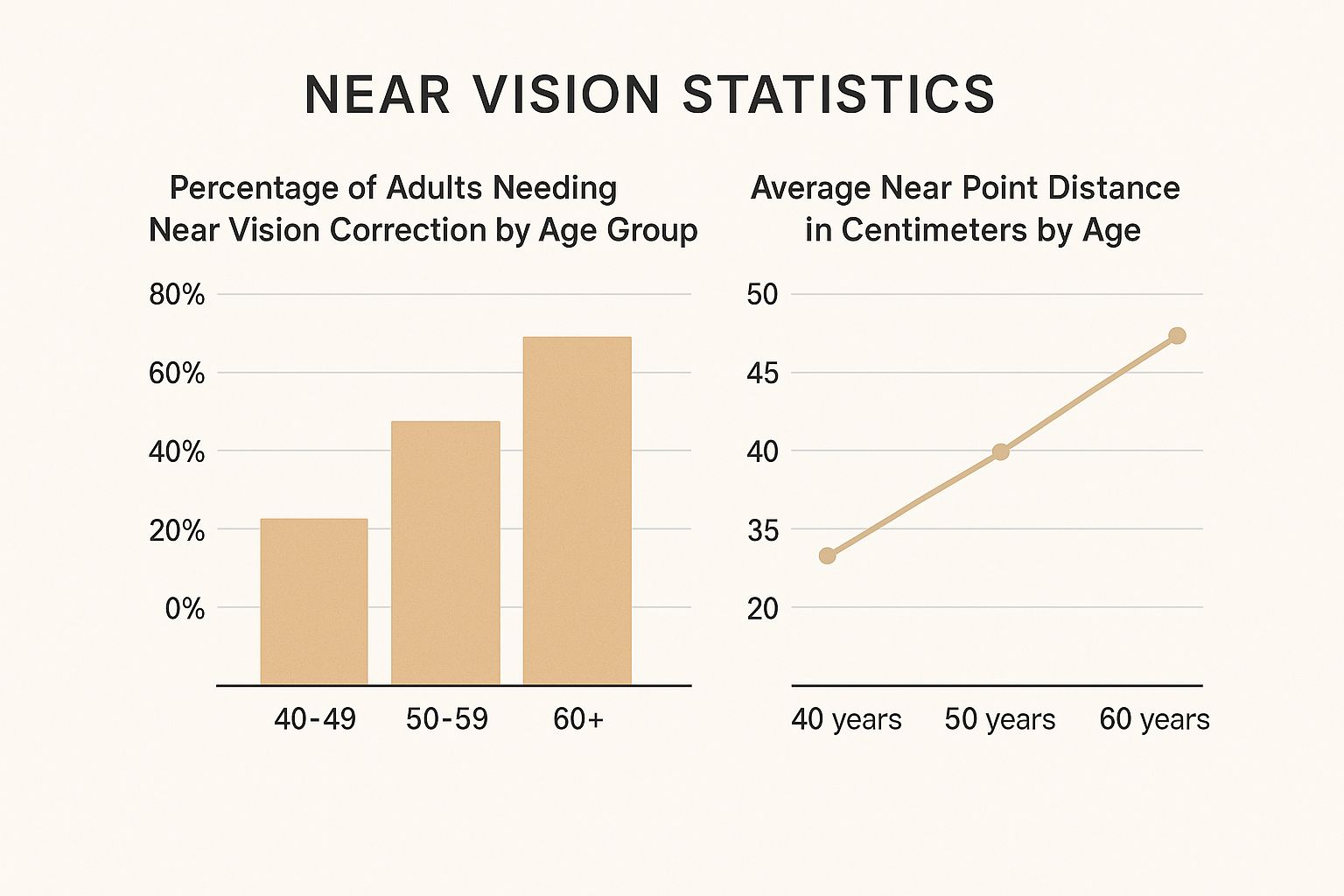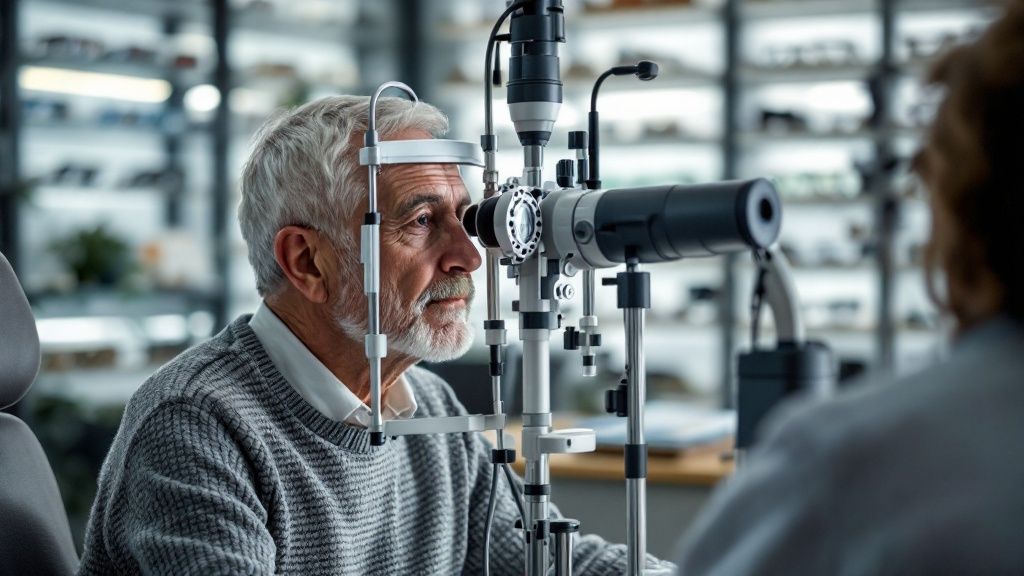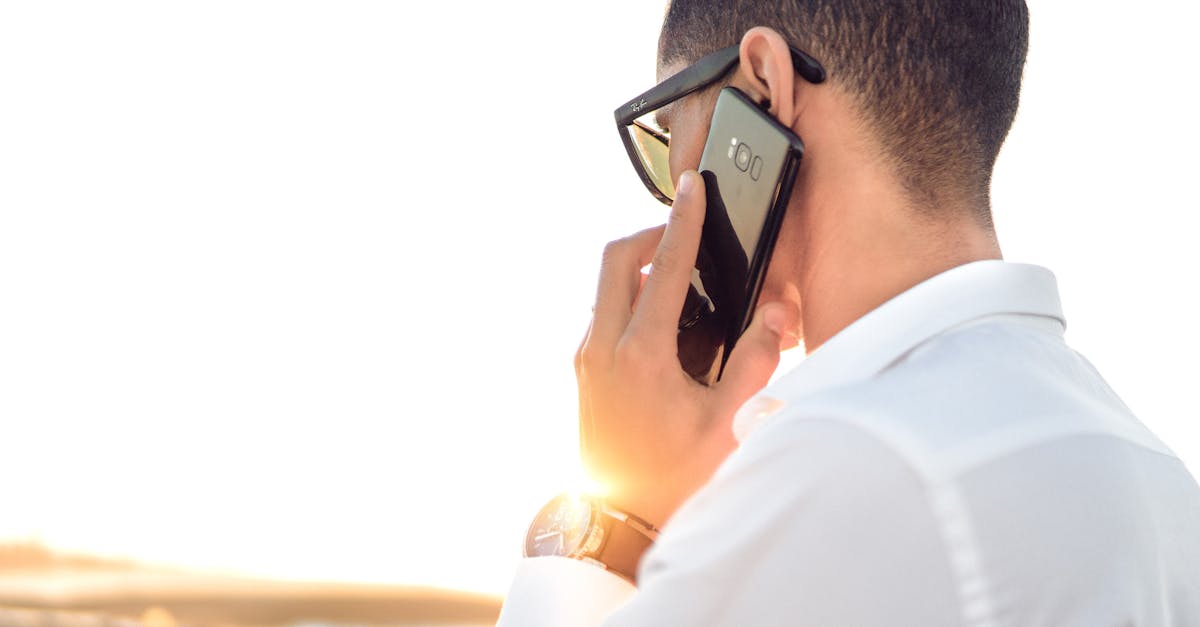Are you suddenly holding menus, books, or your phone at arm's length just to see the words clearly? If you've ever felt like your arms are "too short" to read something, that's one of the classic, tell-tale signs that you might be developing presbyopia. It's a completely normal part of aging that we see often here in Glendale Heights, but it definitely changes how you see the world up close.
Spotting the Early Signs of Vision Changes
Those first hints of needing reading glasses or bifocals are often subtle. You might find yourself needing to turn on an extra lamp to read at night, or maybe you're getting more frequent headaches after a long day of working on the computer.
These aren't just minor annoyances; they're often the first whispers of presbyopia. This condition happens when the natural lens inside your eye loses some of its flexibility, making it harder to focus on nearby objects. This is a standard part of how your eyes change with age. For many of us, these shifts start quietly and we barely notice them until they become a daily frustration.
Is It Presbyopia or Just Tired Eyes?
It’s easy to brush off blurry text as simple eye strain from a long day. But there’s a key difference. While general eye strain usually goes away after you rest your eyes, the symptoms of presbyopia are consistent and tend to get a little worse over time.
You're not alone in this. An estimated 128 million people in the U.S. have presbyopia, and that number is growing. It's a huge reason why the global market for bifocals is projected to hit $10.2 billion by 2033. This isn't some rare condition; it's a shared experience for most people as they get older.
To help you tell the difference, here's a quick breakdown of common symptoms.
Presbyopia Symptoms vs Normal Eye Strain
| Symptom or Sign | Could Be Presbyopia If… | Likely Just Eye Strain If… |
|---|---|---|
| Blurry Close-Up Vision | It’s a constant issue when reading or using your phone. | It happens after hours of intense focus and gets better with rest. |
| Holding Things Farther Away | You reflexively extend your arm to see text clearly (the "trombone effect"). | You only do this when you’re tired or in low light. |
| Headaches | They happen after doing close-up work like reading or sewing. | They occur after long screen time but aren't tied to a specific focus distance. |
| Eye Fatigue | Your eyes feel tired or strained from simple tasks like reading a menu. | Your eyes feel tired at the end of a long day, regardless of the task. |
If the symptoms in the "Could Be Presbyopia" column sound familiar, it's a strong indicator that your eyes' focusing ability is changing.
The chart below gives you a great visual of how our need for near vision correction really ramps up as we age.
As you can see, there’s a significant jump in vision correction needs after age 50. The distance at which you can comfortably focus also starts to creep further away. Simply recognizing that these changes are happening is the first and most important step toward getting your vision back on track.
Recognizing the Everyday Clues at Home
Long before you find yourself holding a menu at arm's length, your eyes often drop subtle hints that your vision is changing. These little adjustments you make throughout the day can be so gradual you barely notice them, but they’re powerful clues. Paying attention to these habits is a great way to self-check.
For example, do you find yourself needing brighter light to read a book from the Glendale Heights Public Library? Or maybe you've been bumping up the font size on your phone without even thinking about it. These are classic workarounds for vision that’s struggling up close.
From Your Living Room to Your Car
Think about your daily routine. When you're relaxing in the evening, does it take a moment for your eyes to refocus when you look up from your phone to the TV? That little lag is a tell-tale sign that your eyes are working overtime to switch between different distances.
Driving is another place where the signs become obvious. You can see the road signs on North Avenue just fine, but a quick glance down at your speedometer or GPS is a blurry mess. This specific struggle—clear distance vision but fuzzy intermediate and near vision—is the hallmark of needing a new kind of lens.
Key Takeaway: If you’re regularly getting headaches or your eyes just feel exhausted after reviewing receipts from stores on Bloomingdale Road or spending time on your laptop, it’s a red flag. That’s your eyes telling you they're struggling to maintain focus up close.
This kind of recurring discomfort is often an early warning. In fact, headaches and eye strain are common symptoms of computer vision syndrome, which can easily overlap with the first signs of presbyopia.
If these scenarios sound all too familiar, it’s a clear signal. You’re not just imagining it, and it's probably time to get a professional opinion from the best optometrist in Glendale Heights.
Understanding How Bifocals and Progressives Work
If you hear "bifocals" and picture your grandfather's glasses with that tell-tale line across the middle, you’re not alone. But that image is a bit outdated. Today’s multifocal lenses are sophisticated pieces of technology designed to solve a very common problem: needing different glasses for different distances.
At its most basic, a traditional bifocal lens combines two distinct prescriptions into one. The top portion is for seeing far away, and a small, dedicated segment at the bottom is for close-up work like reading a book. It’s a beautifully simple solution that ends the constant juggling of multiple pairs of glasses.
The Modern Alternative: No-Line Progressives
For a seamless look and a more natural visual experience, most people today opt for progressive lenses. You might hear them called "no-line bifocals," and for good reason—they provide a smooth, gradual transition between prescriptions without any visible lines on the lens.
Instead of an abrupt jump from distance to near vision, progressives offer a gentle gradient of focusing power. This allows your eyes to move naturally between looking at the road ahead, glancing at your GPS, and then reading a text message, all with clear, uninterrupted vision.
This kind of innovation is why the global market for these lenses was valued at over $8 billion. As the technology gets better, more and more people are choosing this seamless approach to vision correction.
Finding the Right Fit for Your Lifestyle
So, how do you choose? Deciding between traditional bifocals and modern progressives really comes down to your daily routine and what feels most comfortable for you. The best first step is always a conversation with an eye care professional who understands your lifestyle.
For a deeper dive into which lens type might be your perfect match, take a look at our detailed guide on progressive lenses vs. bifocals.
Here at iDoctor, we specialize in pairing these advanced lenses with frames you'll love to wear. We can help you find the perfect pair of designer eyeglasses in Glendale Heights, combining cutting-edge lens technology with timeless style from brands like Gucci, Tom Ford, and Cartier.
It's Time for a Professional Eye Exam—Here's When to Go
If those at-home checks we talked about are starting to feel like your new normal, and you've been struggling for a few weeks, it's time to stop guessing. Relying on makeshift solutions like cranking up the lights or zooming in on your phone is just a temporary patch, not a real fix.
The only way to get genuine clarity is through a professional diagnosis. While the signs often point straight to presbyopia, they can sometimes be a red flag for other eye health issues that only a comprehensive exam can uncover. This is where getting expert care in Glendale Heights really shines.
Why a Professional Diagnosis Is Non-Negotiable
Getting an accurate diagnosis is about so much more than just confirming you need bifocals. It's about getting a complete picture of your visual health. A professional is the only one who can dial in your exact prescription and walk you through the best lens options that fit your actual lifestyle.
And you're not alone in this. The global market for bifocal lenses hit an estimated USD 8.5 billion in 2023, with North America at the forefront. This isn't just a number; it shows how many people are turning to professionals for real solutions to age-related vision changes.
You can't account for all the subtle nuances of your eye health on your own. A professional exam is the only way to rule out other conditions and make sure you get the right corrective lenses for your unique needs.
Scheduling a visit with an eye doctor in Glendale Heights gives you peace of mind. We can definitively figure out if presbyopia is the cause or if there's something else going on.
Our detailed eye exams in Glendale Heights use high-resolution imaging to see the full story of your vision. This technology lets us create a solution that works for you—whether you spend your days in front of a computer or your weekends out at East Branch Forest Preserve.
Ready for Clearer Vision in Glendale Heights? Here’s What to Do Next
Let's be honest, realizing your arms aren't long enough to read your phone is a frustrating moment. It's often the first real sign that your near vision is starting to change. The good news? It's a completely normal part of aging, and the solutions today are worlds away from the clunky bifocals you might be picturing.
You don't have to keep juggling different pairs of glasses or putting up with end-of-day headaches from eye strain. Those little annoyances are your cue to get some real answers.
We Make Finding the Right Fit Easy
Here at iDoctor, we're not just about eye charts and prescriptions. We're your neighbors in Glendale Heights, and our goal is to make the entire process comfortable and even a little bit fun. We firmly believe that your new glasses should be a stylish accessory you love to wear.
Whether you're curious about traditional bifocals or want the seamless, modern look of no-line progressive lenses, our team will walk you through everything. We'll help you find the perfect lens technology to match your daily life.
Come by our Glendale Heights boutique and see for yourself. We've hand-picked our collections to have something for everyone.
- Explore timeless classics from Ray-Ban and Coach.
- Discover our exclusive selection of designer eyeglasses in Glendale Heights.
- Try on luxury frames from iconic brands like Cartier, Gucci, and Tom Ford.
Our Promise: We don't just sell you glasses. We're here to provide a personalized vision solution that works for you. Your clarity and comfort are what matter most.
The single best way to get a definitive answer and see all your options is to come in for a comprehensive check-up.
Let's work together to get your world back in focus. Book your detailed eye exam in Glendale Heights today and see clearly again.
FAQs for Our Glendale Heights Patients
Over the years, we've helped countless people in Glendale Heights and the surrounding Chicagoland suburbs make the switch to bifocals and progressives. Here are the straight-up answers to a few common questions.
1. What’s the "right" age for bifocals?
People usually start noticing the tell-tale signs of presbyopia—that frustrating blurriness with up-close tasks—right around 40 to 45 years old. But honestly, that’s just a number. Your personal timeline depends on things like your family history and daily activities. The real signal isn't your birthday; it's whether you're constantly holding your phone farther away to read a text. If that sounds familiar, it's time for a visit.
2. Does my vision insurance cover designer progressive lenses at iDoctor?
Yes, absolutely. We proudly accept all major vision insurance plans here at iDoctor. Most policies provide excellent coverage for corrective lenses, including both standard bifocals and modern no-line progressives. Our Glendale Heights team is expert at navigating benefits and will handle the paperwork to ensure you get the most out of your plan, whether you choose frames from Cartier or Kate Spade.
3. I work from a computer all day. Are bifocals or progressives better for that?
That's a great question. While both can work, many of our patients who spend hours on screens prefer progressive lenses. They offer a smoother transition between your computer screen (intermediate distance) and your keyboard (near distance) without the abrupt "jump" of a traditional bifocal. During our 30-minute detailed eye exam, we can discuss your specific work habits and recommend the perfect solution for you.
Ready to get clear answers for your own eyes? At iDoctor, we’re all about providing expert care with a boutique experience right here in Glendale Heights. Visit us online to learn more or book your exam in Glendale Heights.








